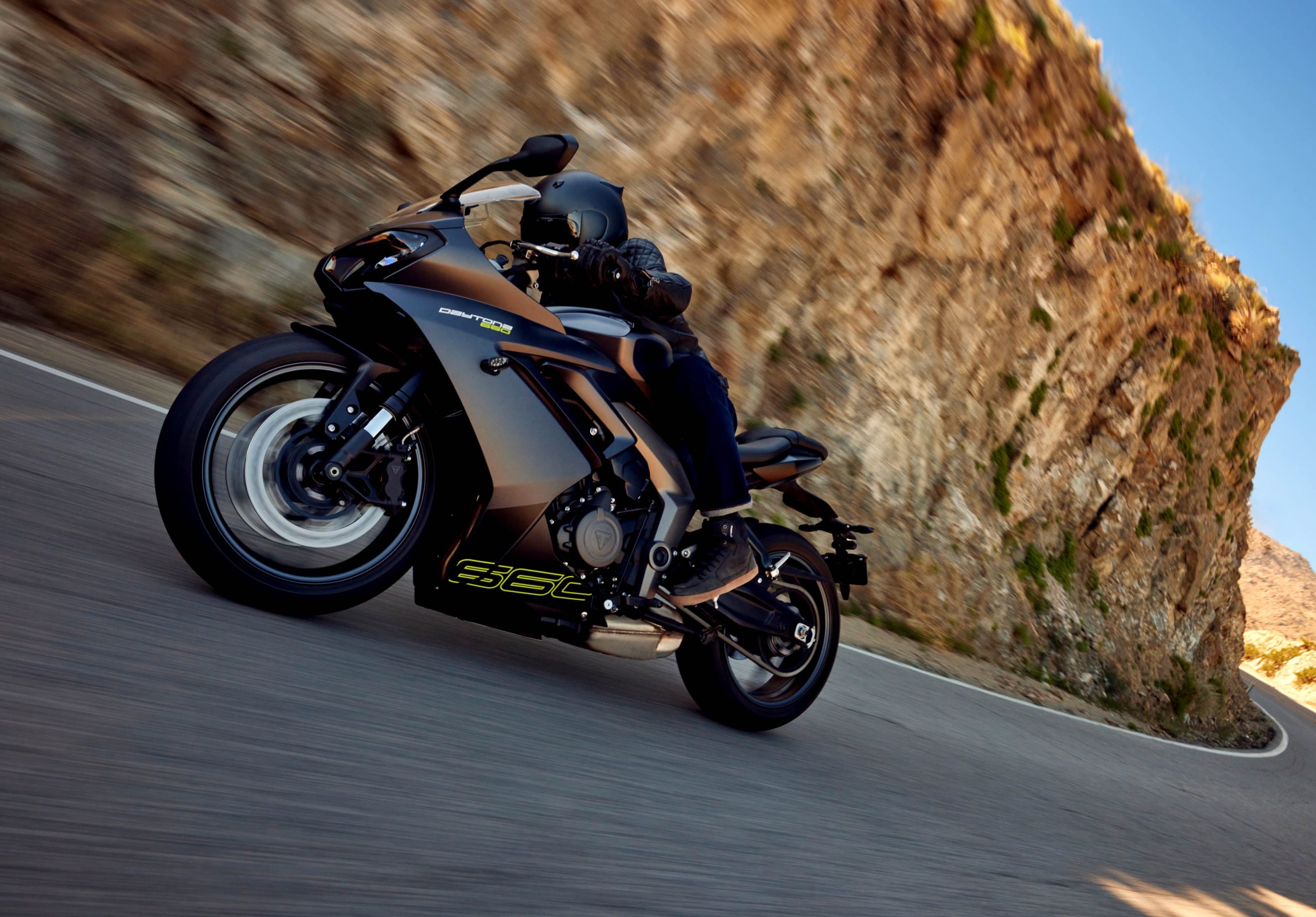
Hard core sport bikes don’t sell like they used to, but a new category of more practical, sporty machines with less severe ergonomics has risen. Kawasaki’s Ninja 650, Honda’s CBR650R and Suzuki’s GSX-8R come to mind. You can now add Triumph’s newly announced Daytona 660 to this category, and it is a very compelling machine.
Priced at $9,199 and making a claimed 94 horsepower from its three-cylinder engine, the new Daytona 660 substantially out-powers the competition while being cheaper than the GSX-8R and the CBR650R.
The displacement of the new Daytona 660 is identical to that of the naked Triumph Trident, but the Daytona makes 13 more horsepower courtesy of several changes, including a new crankshaft, cylinder head and camshafts. The new motor also gets three throttle bodies where the Trident makes due with a single throttle body. The new engine revs higher, but surprisingly makes similar torque down low as the Trident.
The Daytona 660 should be in U.S. dealers this March. Here is the press release from Triumph:
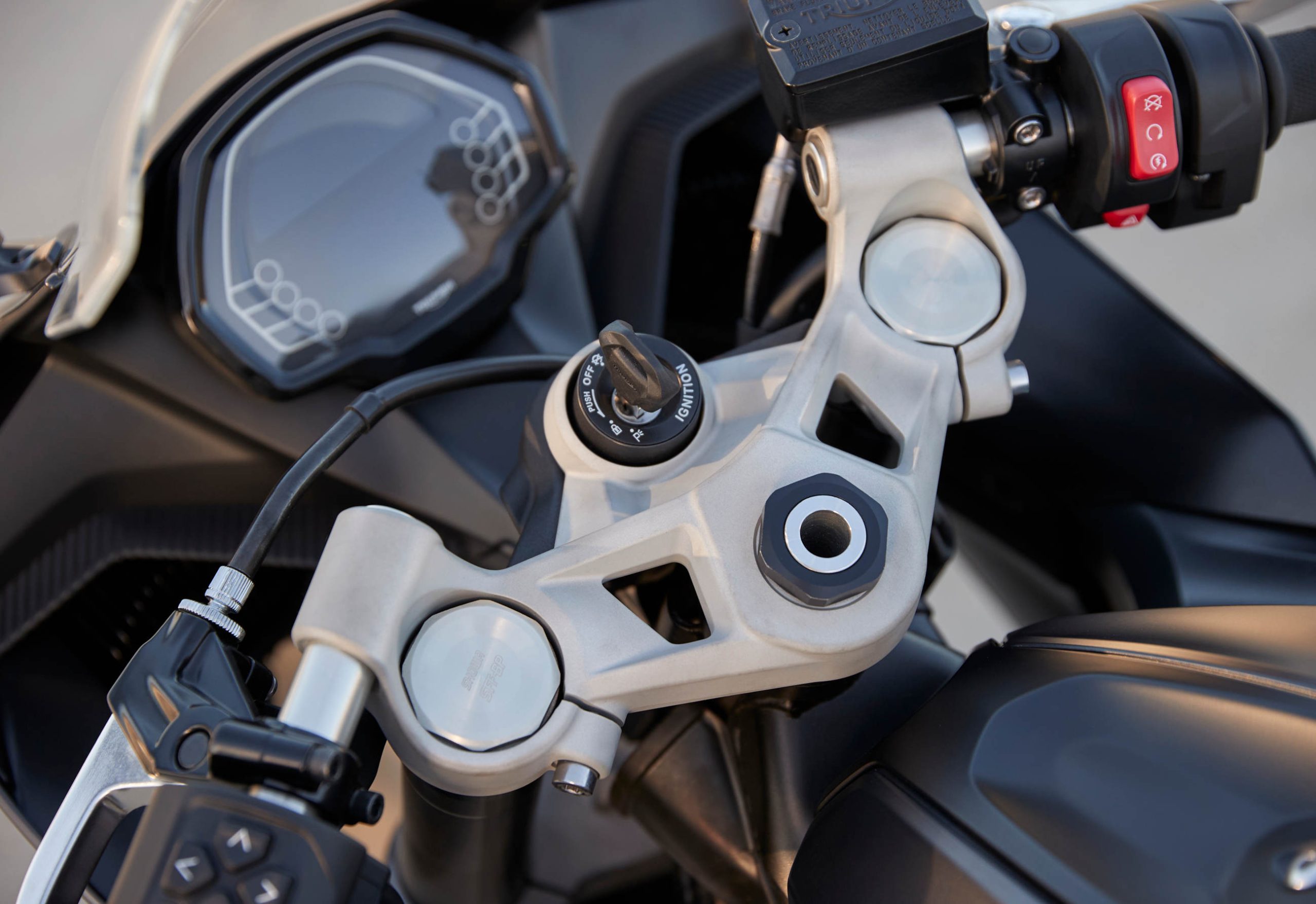
- A legendary name reborn for a new generation – the all-new middleweight sports leader
- Thrilling triple-powered sports performance – 95PS peak power and 69Nm peak torque
- Intuitive, agile sports handling – with all-day riding comfort
Triumph has revealed an all-new triple powered middleweight sports bike for 2024. The Daytona 660 delivers thrilling sports performance, a dynamic ride and the highest quality, capability and specification in its class.
Featuring a significant evolution of Triumph’s distinctive and unique 660cc triple engine, now with 95PS peak power and 69Nm of peak torque, the Daytona 660 provides a smooth, responsive and linear delivery with the perfect combination of low-down torque, mid-range and top-end power. As well as delivering 17% more power and 9% more torque than the Trident, the Daytona 660 also has a brand-new exhaust, creating an unmistakeable sports soundtrack.
The Daytona 660’s perfectly balanced chassis and intuitive, agile sports handling is combined with all-day riding comfort, thanks to high specification equipment including Showa upside down big piston 41mm forks and Showa preload adjustable monoshock RSU. The radial four piston brakes with twin 310mm discs and braided brake lines are paired with Michelin’s new Power 6 tyres.
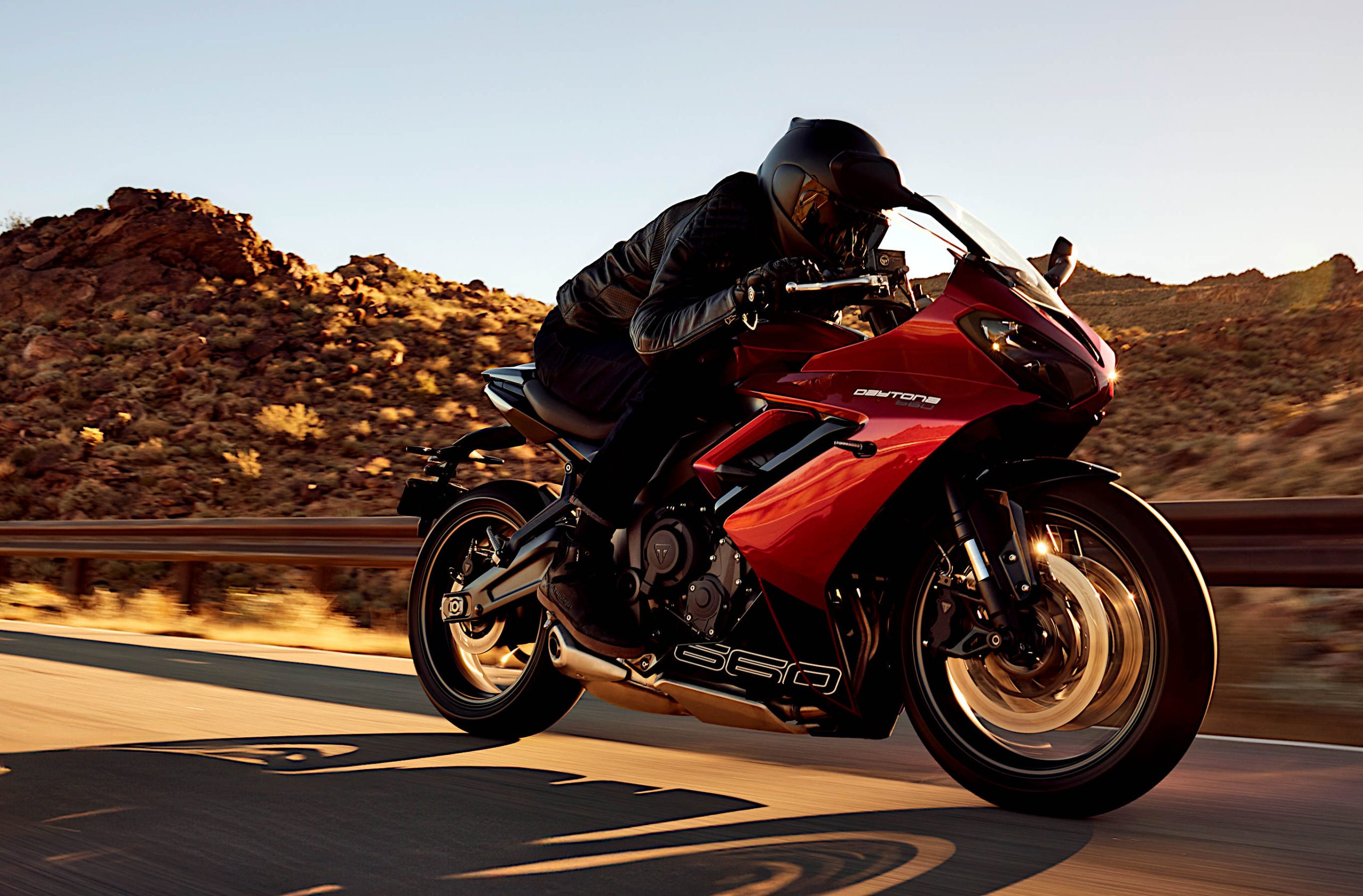
Combined with an 810mm seat height, narrow stand-over and optimised bar and footpeg position, the Daytona 660 delivers an exciting and confidence-inspiring ride.
Ensuring riders always feel in complete control, the Daytona 660 is equipped with rider-focused technology including three riding modes (Sport, Road and Rain) which optimise throttle response and traction control settings for the conditions, plus there’s a new Emergency Deceleration Warning system that activates the hazard lights to alert other road users during heavy braking.
The unmistakeable Daytona design DNA has been reimagined with fresh attitude for an aggressive new stance and clean lines. Distinctive twin LED headlights incorporate a central air intake and the minimal bodywork emphasises the athletic profile, ending in a contoured LED tail light. There are three striking colour options available, all featuring a bold ‘660’ race-inspired graphic.
As Triumph customers would expect, the Daytona has more than 30 Genuine Triumph Accessories to tailor performance, comfort, style and practicality, including an A2 licence kit, with a dedicated throttle twist grip and an engine tune that limits power to 35kW.
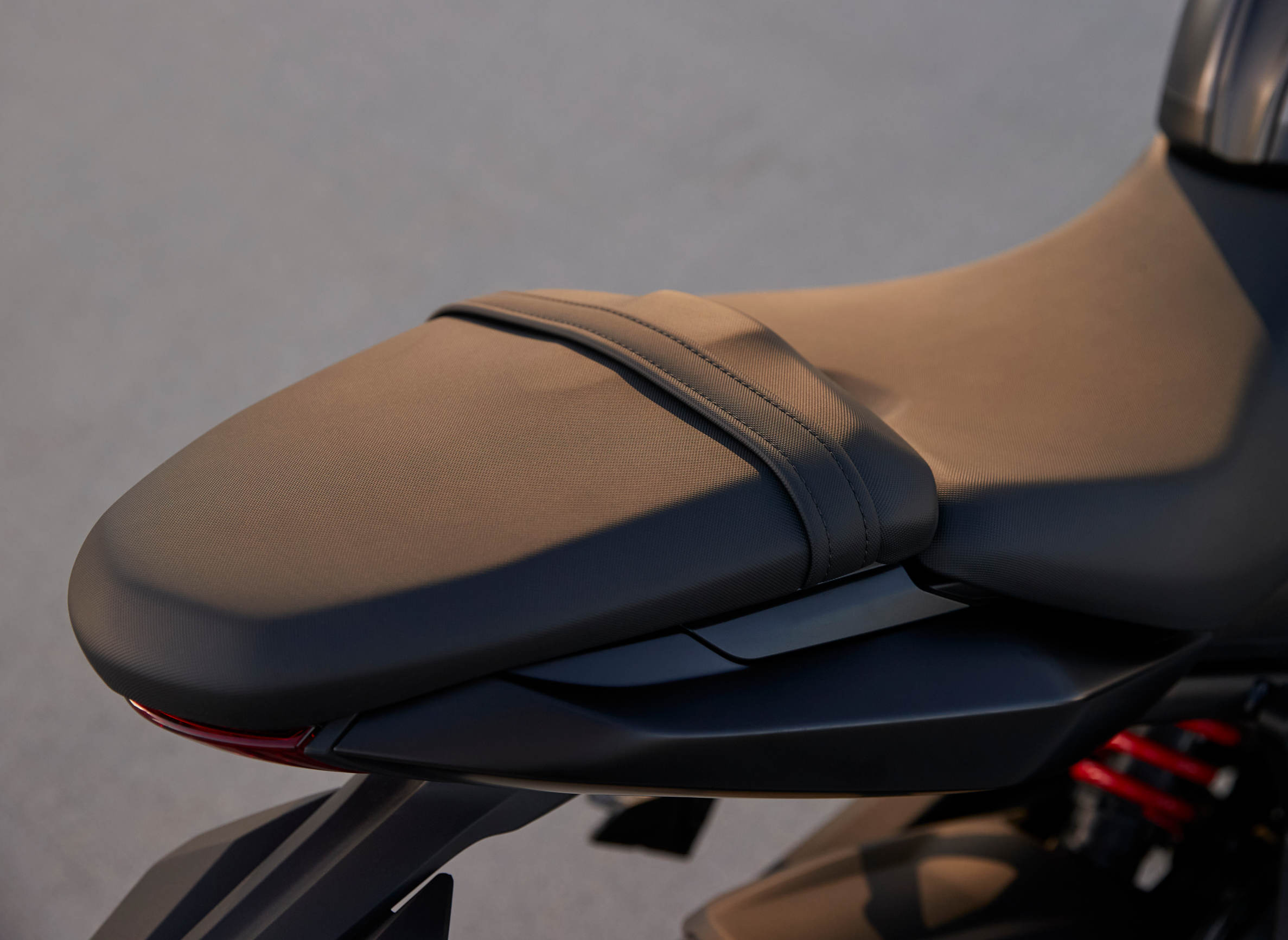
A 10,000-mile service interval, two-year unlimited mileage warranty and Triumph’s strong residual values contribute to securing a competitive cost of ownership, the lowest in the class.
Steve Sargent, Triumph’s Chief Product Officer said: “The 660 has all the attitude and agility you’d expect from the Daytona name, and brings with it the thrilling, useable, real world performance and all-day comfort that riders today are looking for. We are excited by the impact the Daytona 660 is going to have on the growing middleweight sports world.”
THRILLING SPORTS PERFORMANCE
The perfect combination of low-down torque, thrilling top-end and unrivalled character, the Daytona’s triple delivers 95PS at 11,250rpm with a hair-raising 12,650rpm redline. More than 80 percent of its 69Nm of peak torque is available from just 3,125rpm delivering responsive sporty and fully usable performance. By blending low-down torque and the tractability of a twin with the free-revving top end performance of an inline four, the engine has a unique triple soundtrack, further enhanced by the new exhaust which features 3 into 1 headers and a compact underslung silencer with stainless steel finisher.
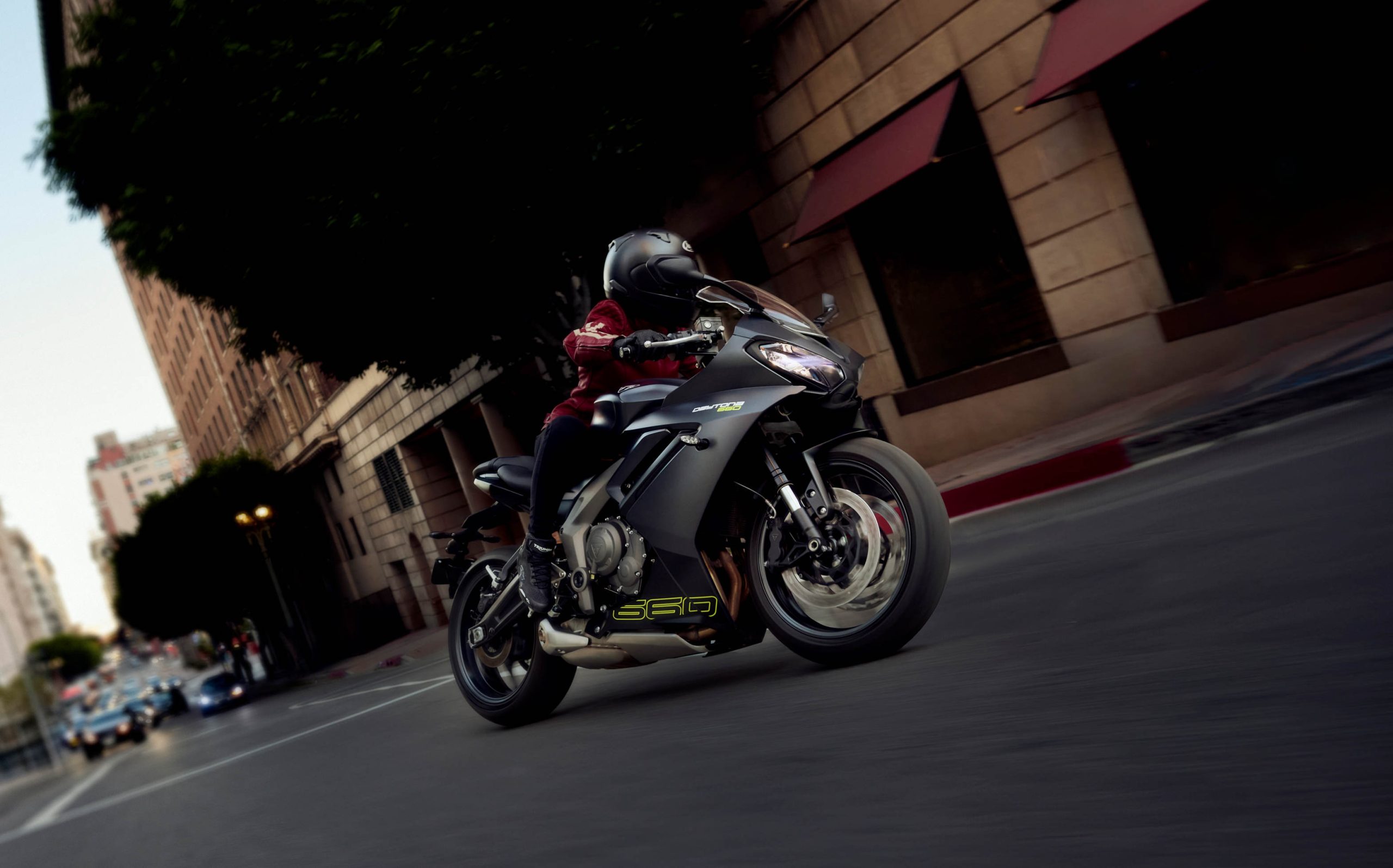
Power is delivered effortlessly through a slick six-speed gearbox and Triumph’s Torque Assist clutch ensures a progressive, light lever action with a span optimised clutch lever for better reach. The clutch design also improves rear wheel control under hard deceleration for smooth, confident corner entry. Triumph’s Shift Assist is available as an accessory fit for fast and effortless clutch-less up and down shifts and even easier riding in town.
For riders starting their Daytona ride with an A2 licence, an accessory fit conversion kit enables compliance with a replacement throttle grip and unique engine tune, that can be easily fitted, or reverted to standard, by a Triumph dealer.
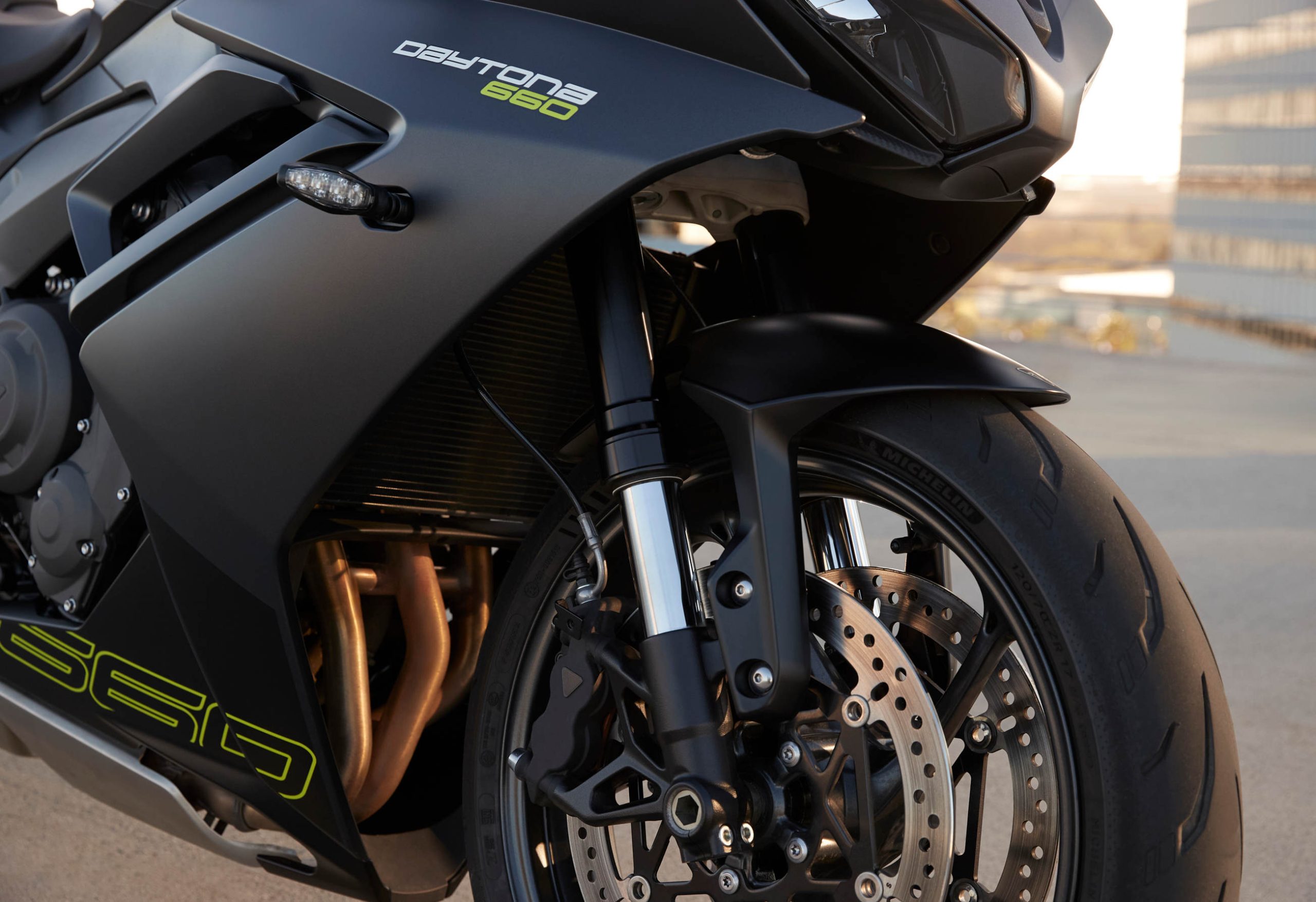
AGILE, DYNAMIC RIDE
The new Daytona 660 benefits from years of race-winning chassis development, and with its
lightweight sports frame, top quality Showa 41mm upside down, big-piston front forks and a Showa rear suspension unit, it delivers an easy and agile ride. The rear suspension also features preload adjustment for quick set-up alterations.
Lightweight five-spoked cast aluminium wheels keep rotating mass low for even more responsive handling and enhanced suspension performance and Michelin’s new high-specification Power 6 tyres are fitted as standard to deliver confident road handling in wet and dry conditions. With twin four-piston radial calipers paired to lightweight 310mm discs and fed by braided lines, plus a Continental ABS modulator, the Daytona 660 has excellent stopping power and braking feel too.
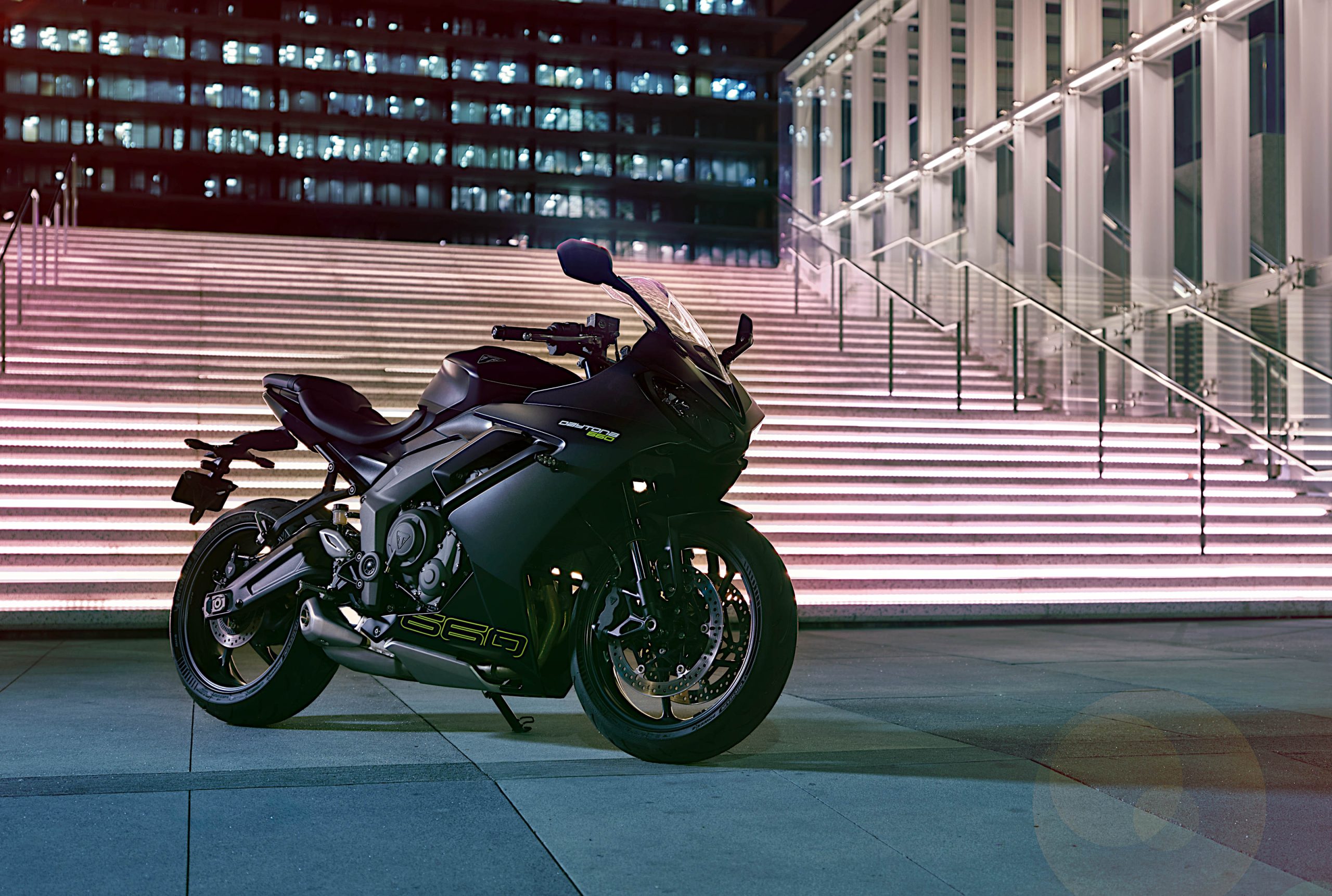
RIDER-FOCUSED TECHNOLOGY
The Daytona 660 features technology that enhances the riding experience and safety.
The ride-by-wire throttle delivers a crisp and precise throttle response and also allows for three riding modes; Sport, Road and Rain. Each mode offers a different throttle response and level of traction control intervention, with Sport mode providing the most reactive throttle response for full-on road rides or track sessions. The traction control system can also be turned off using the instrument menu for riders who prefer complete freedom from electronic intervention.
The multi-functional instruments feature a colour TFT screen integrated into a white-on-black LCD display. Compact, and with an uncluttered design, all the rider information is clearly displayed and is easy to read in different light conditions. This neat unit is compatible with the accessory fit My Triumph Connectivity System that enables turn-by-turn navigation plus phone and music interaction. All functions are clearly displayed on the TFT screen and controlled via the switchgear for ease of use while riding.
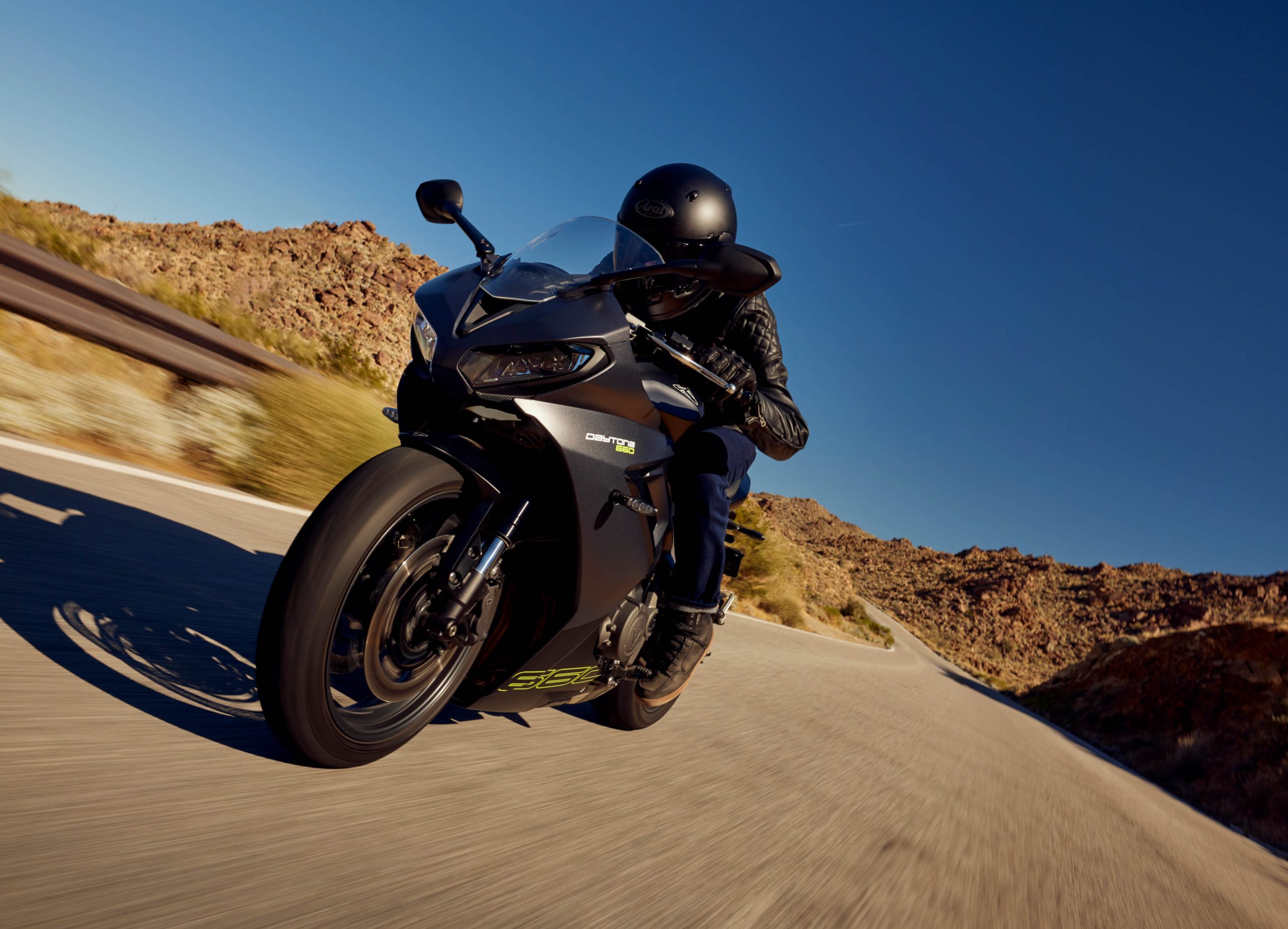
CONTROL & COMFORT
With racy clip-on bars positioned above the top yoke and pegs placed for the optimum balance of comfort and cornering clearance, the Daytona 660’s natural riding position is perfectly judged to give the feedback needed for dynamic sports riding with space and comfort necessary for long days in the saddle. At lower speeds, the Daytona’s perfectly-weighted controls and light steering give superb control in urban environments.
Split rider and pillion seats, with a rider seat height of 810mm and a narrow stand-over make the Daytona 660 manageable for riders of all sizes, and an accessory low seat is also available, lowering the seat height by 25mm to just 785mm.
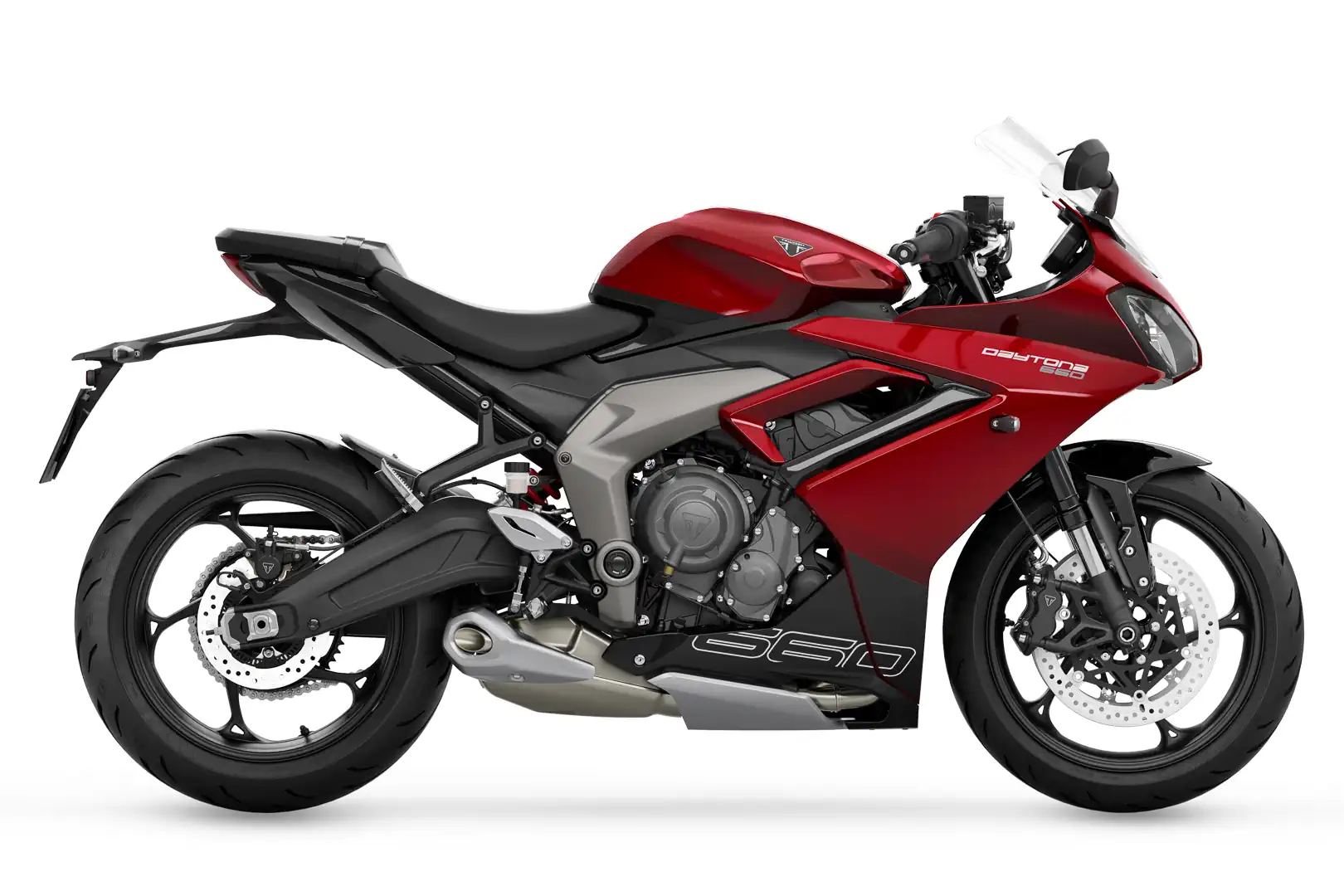
MAKE THE DAYTONA 660 YOUR OWN
There are over 30 Genuine Triumph Accessories available, all engineered alongside the motorcycle, tested to the same high standards, and carrying the same two-year unlimited mileage warranty.
Riders looking for an even more distinctive race paddock style can choose a colour-coded seat cowl as well as a range of beautifully engineered billet-machined parts including an oil filler cap, pre-drilled for lock-wiring, paddock stand bobbins, bar end finishers and a rear brake reservoir.
The My Triumph Connectivity System allows easy and intuitive phone and music operation plus turn-by-turn navigation and is available as an accessory on the Daytona 660. Triumph Shift Assist can also be added, providing clutch-less, full-throttle upshifting and seamless downshifting with auto-blip.
Other additions include heated grips, an under-seat USB socket and a tyre pressure monitoring system (TPMS). A tank bag and tail pack are also available, adding 20 litres of stylish carrying capacity.
New security accessories, subject to availability by market, include the Triumph Protect+ alarm system, and Triumph Track+ tracker with 24/7 monitoring as well as comprehensive range of locks.
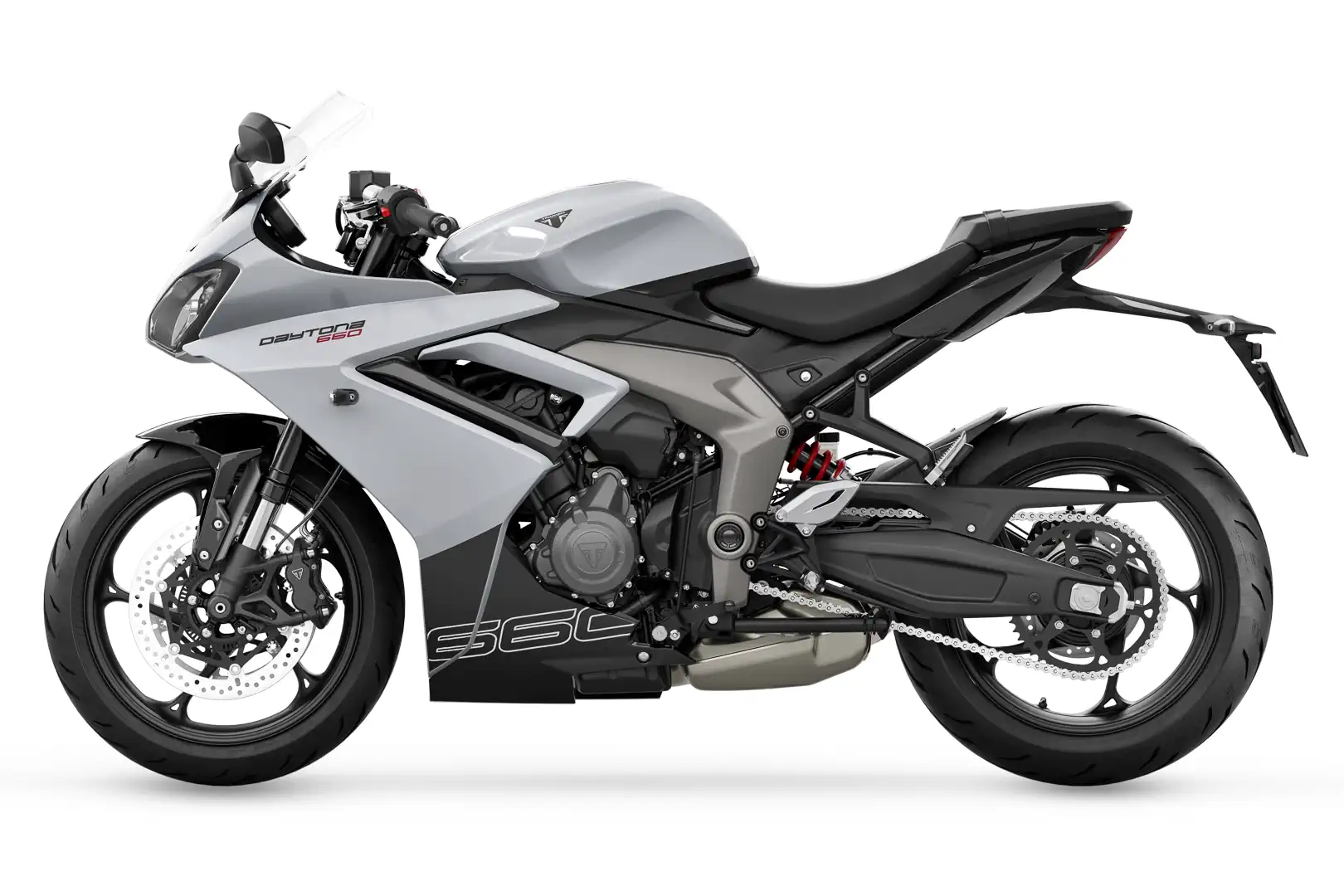
ON THE ROAD
Customers can find out more at triumphmotorcycles.co.uk or place an order with their local Triumph dealer, with bikes arriving in dealerships from end of March 2024.
SPECIFICATIONS
ENGINE AND TRANSMISSION
| Type | Liquid cooled, inline 3-cylinder,12 valve, DOHC, 240° Firing order | |
| Capacity | 660cc | |
| Bore | 74.04mm | |
| Stroke | 51.1mm | |
| Compression | 12.05:1 | |
| Maximum Power | 70 kW (95PS) at 11,250 rpm | |
| Maximum Torque | 69 Nm @ 8,250 rpm | |
| Fuel System | Multipoint sequential electronic fuel injection with electronic throttle control | |
| Exhaust | Stainless steel 3 into 1 header system with low single sided stainless steel silencer | |
| Final Drive | X-ring chain | |
| Clutch | Wet, multi-plate, slip & assist | |
| Gearbox | 6 speed |
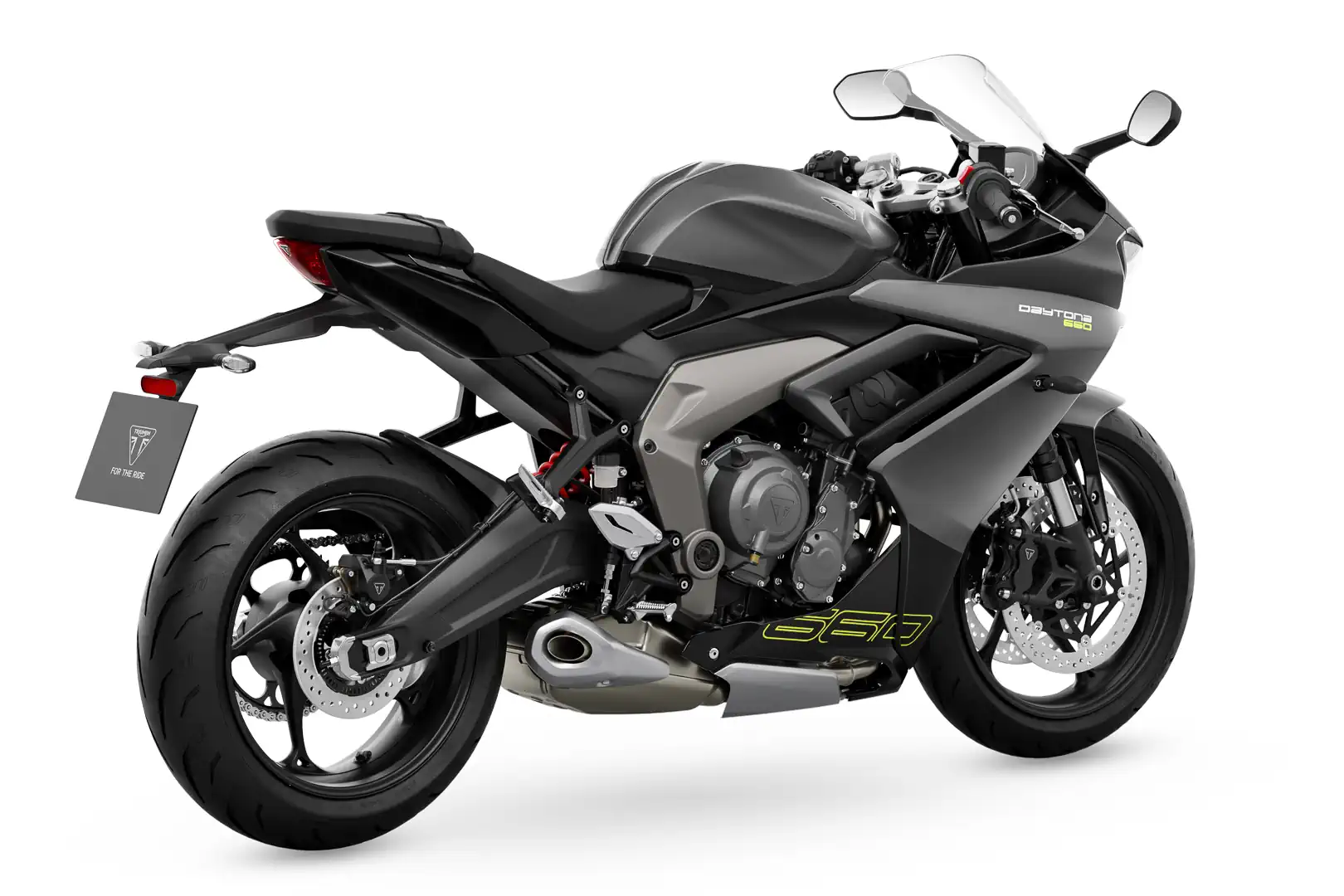
CHASSIS
| Frame | Tubular steel perimeter frame | |
| Swingarm | Twin-sided, fabricated steel | |
| Front Wheel | Cast aluminium alloy 5 spoke, 17 x 3.5 in | |
| Rear Wheel | Cast aluminium alloy 5 spoke, 17 x 5.5 in | |
| Front Tyre | 120/70 ZR 17 | |
| Rear Tyre | 180/55 ZR 17 | |
| Front Suspension | Showa 41mm upside down separate function big piston (SFF-BP) forks, 110mm Wheel travel | |
| Rear Suspension | Showa monoshock RSU, with preload adjustment, 130mm Wheel travel | |
| Front Brakes | Twin 310mm floating discs, 4 piston radial callipers, ABS | |
| Rear Brakes | Single 220mm fixed disc, single piston sliding calliper, ABS | |
| Instruments | Multi-function instruments with colour TFT screen | |
| DIMENSIONS & WEIGHTS | ||
| Length | 2083.8mm | |
| Width (Handlebars) | 736mm | |
| Height Without Mirrors | 1145.2mm | |
| Seat Height | 810mm | |
| Wheelbase | 1425.6mm | |
| Rake | 23.8° | |
| Trail | 82.3mm | |
| Wet weight | 201kg (@90% fuel volume) | |
| Fuel Tank Capacity | 14 litres | |
| FUEL CONSUMPTION | ||
| Fuel Consumption | 57.6 mpg (4.9litres / 100 km) | |
| CO2 Figures | 113 g/km | |
| Emissions Standard | EURO 5+ CO2 emissions and fuel consumption data are measured according to regulation 168/2013/EC. Figures for fuel consumption are derived from specific test conditions and are for comparative purposes only. They may not reflect real driving results. | |
| SERVICE | ||
| Service interval | 10,000 miles (16,000 km) /12 months service interval, whichever comes first | |

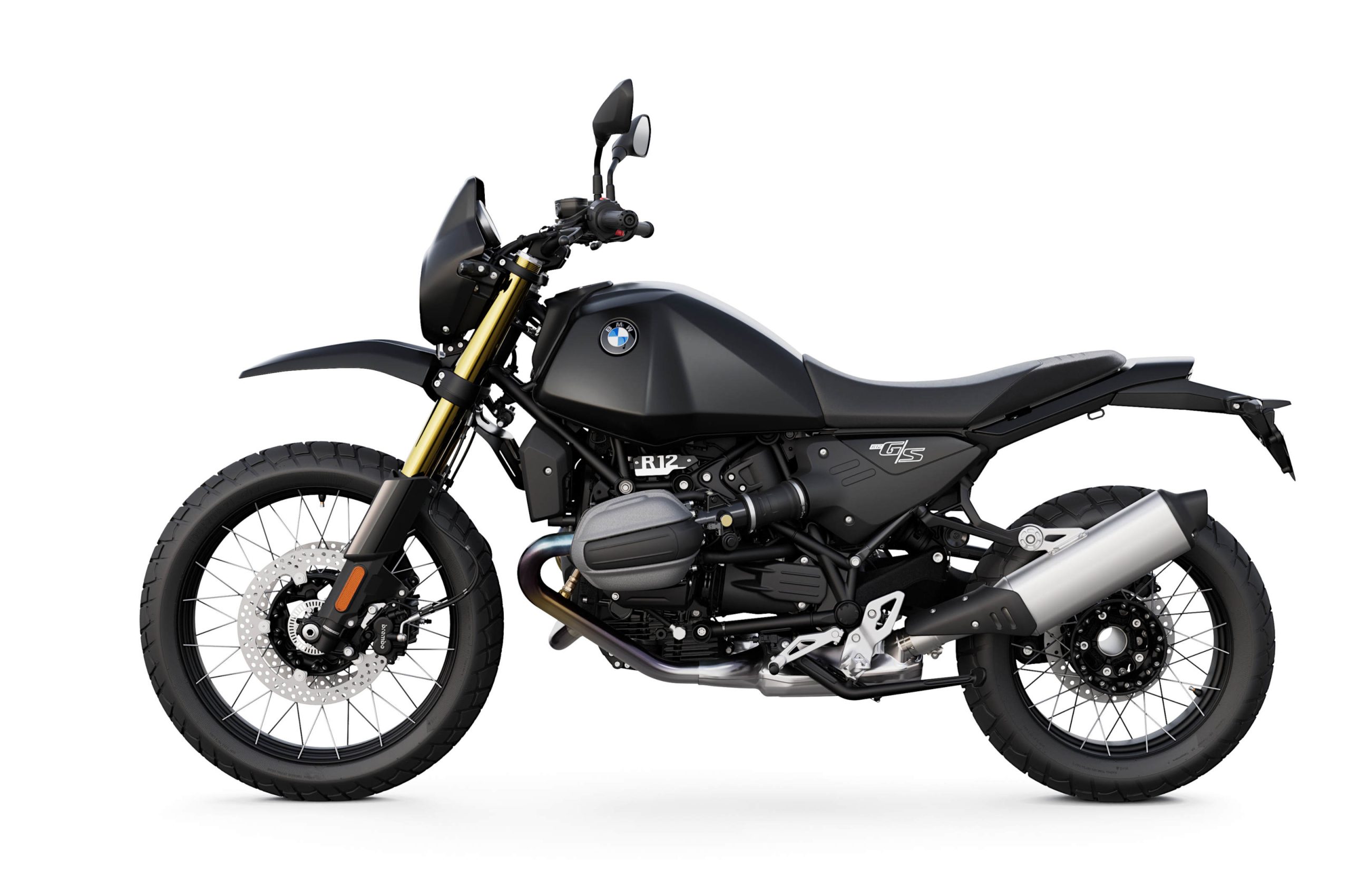
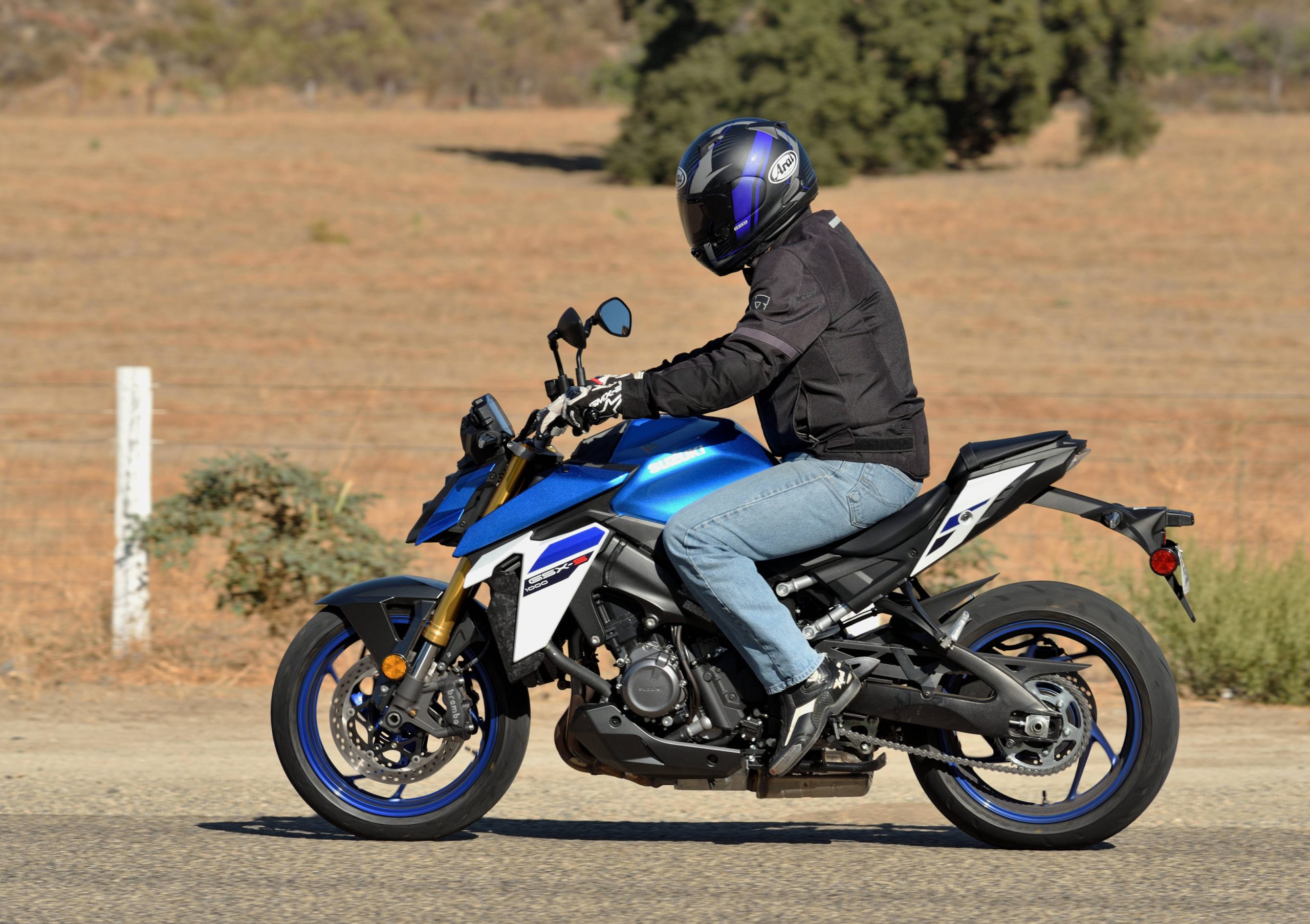
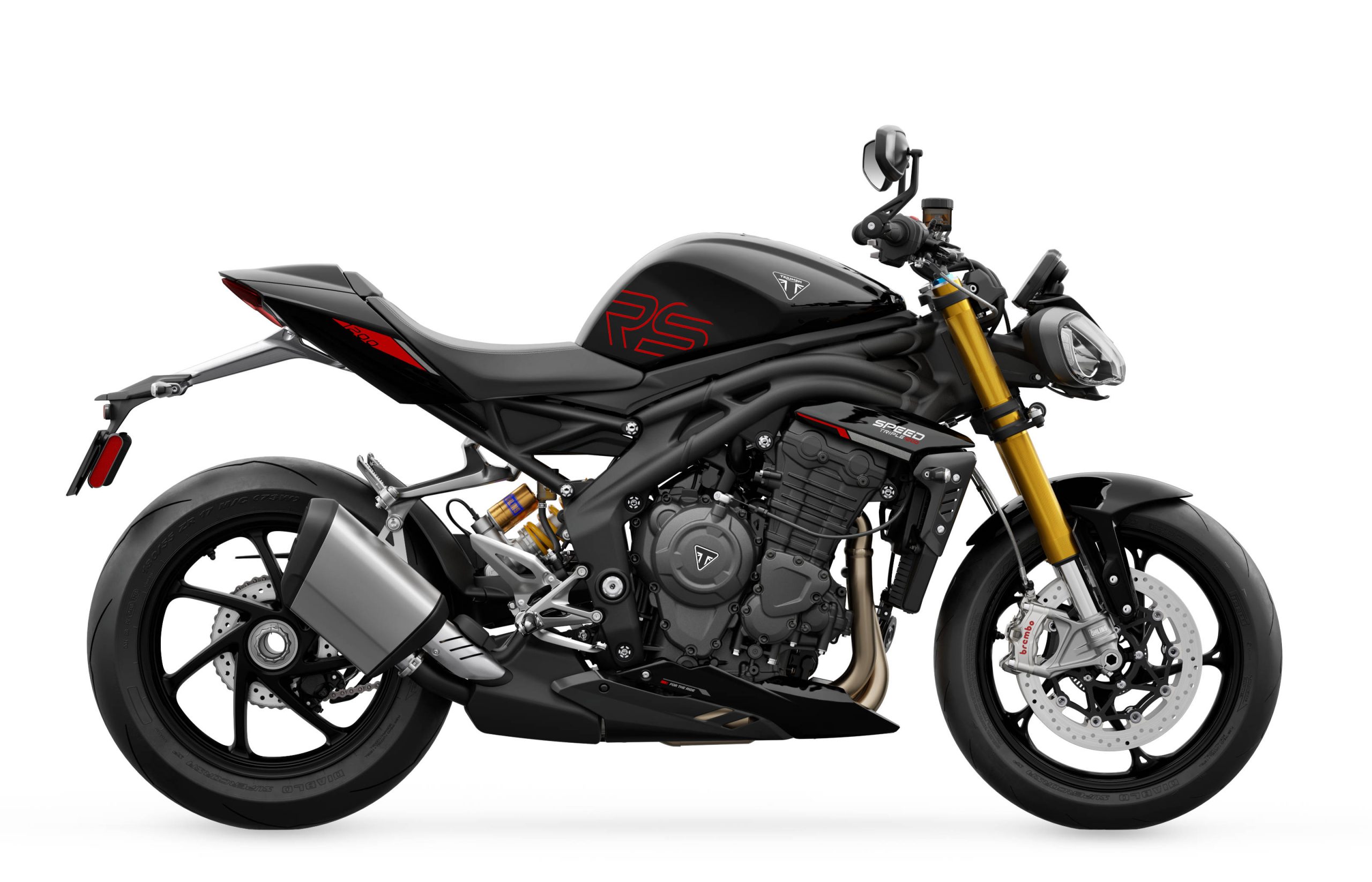
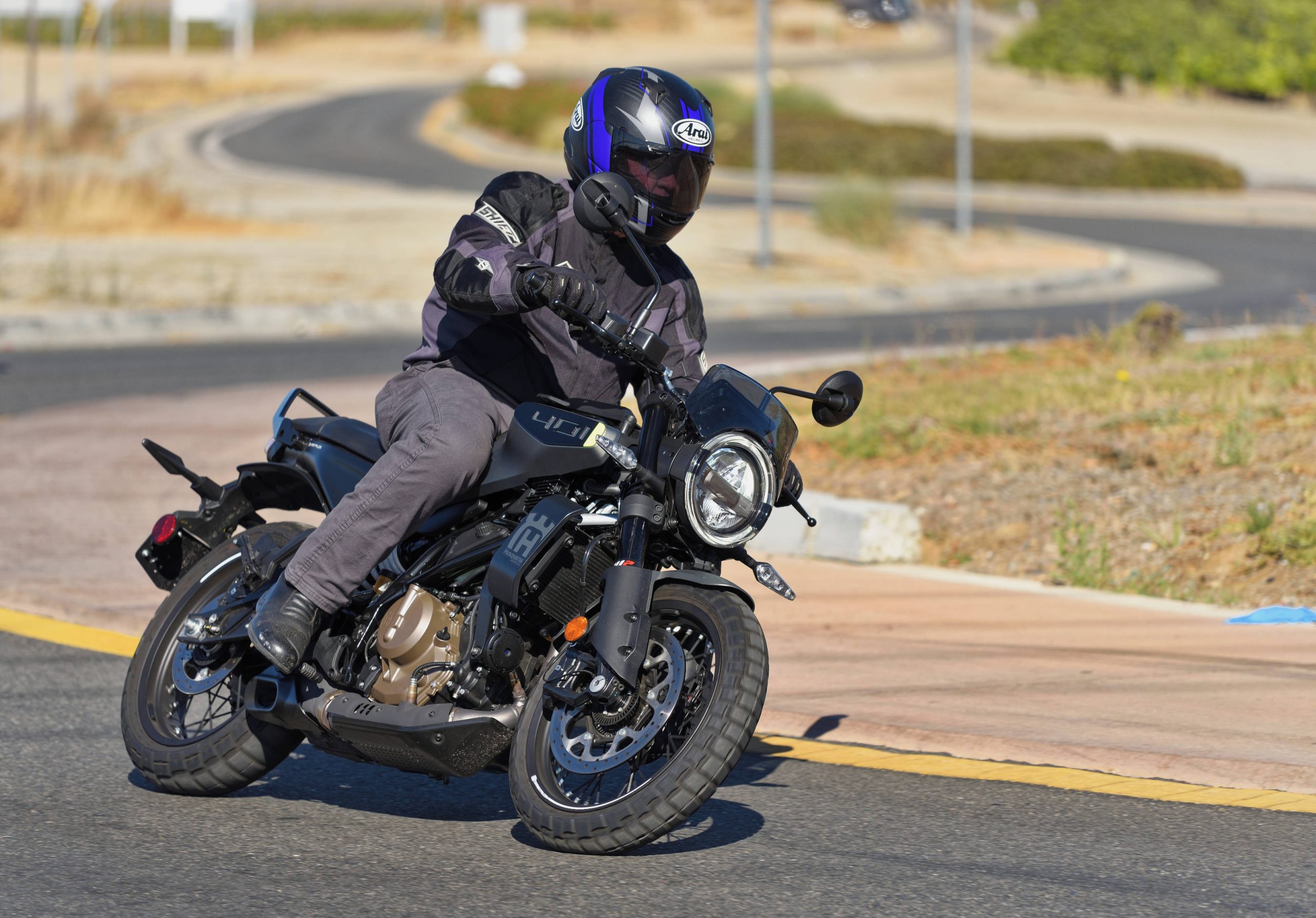
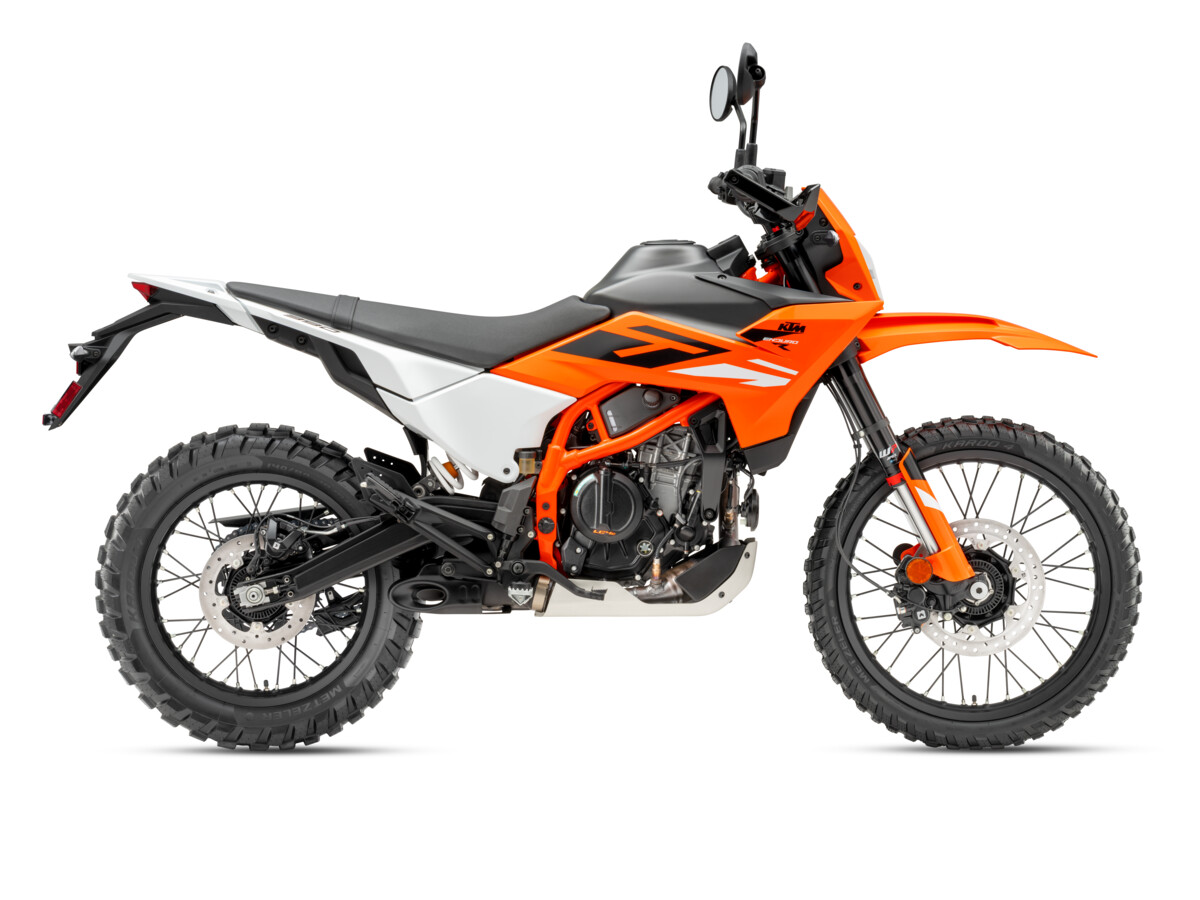
It’s okay I guess.
This bike ticks a lot of boxes for my wife’s next bike. She’s a little bit vertically challenged, and a lot of bikes with good performance are out of reach, literally. The lower seat option (without compromising the suspension action or travel) is a good starting point. Add heated grips, ride modes, and a quickshifter, and all we’re missing from my “favorites” list is the cruise control. The (undoubtedly) sweet triple is icing on the cake. The price is right. The suspension is cheap but that’ll require work for her small stature anyway, so no biggie. I’ll be watching for one out of my peripheral vision.
I’ll never understand the ride modes thing. If an engine needs a handful of tunes, than is isn’t any good. Show me the way to the bikes with good engines. Don’t have any? Craigslist it is.
Some dirt bikes came with a weeny wire that you had to locate and cut to get the real engine. That was annoying. But 90% of dirt bikes are sold to people who never race. That figure must be really high for street bikes. I’ve only raced one of my street bikes. That one was a dirt bike when it came from the factory. It races quite well actually.
Your second sentence is an opinion, Mick, and while I generally tend to agree with you on this, that’s not the only viewpoint having utility.
Ride modes are useful, in my opinion, for bikes like my 1290s. Most of the time I leave them in the same mode, but some conditions are more relaxing with a bit less than 95 pounds of torque, or a little slower throttle response, because my usual ride mode is pretty sporty. Ride modes are not needed on bikes like the T7, or any nicely fueled dirt bike, etc.
I’m talking about a relatively new rider for this 660, hypothetically, moving up from a Duke 200 single, so the idea that there’s something like a rain mode, as part of the transition, is potentially helpful.
I haven’t owned a Triumph but the Yamaha triple I had was a cool engine, and I bet this Triumph is great, as well. Having ride modes probably doesn’t ruin it.
And if one’s ego requires, any bike with ride modes can be left in “kill” mode with it’s ABS switched off in a snowstorm, right?
For me, yes, it ticks a lot of boxes, especially the sweet triple, however at 443 pounds, its about 50 pounds over my ideal weight for a bike of this kind. Now there will be a lot of negative comments on this post. But I’ve owned a lot a bikes, my ’07 GSX-R600 was a great machine. Yes, after an hour my wrists would hurt. Its weight was actually around 20 pounds lighter than this bike. But after riding my Ninja 400 (360 pounds) did I really appreciate the benefits of a lighter weight bike.
The Ninja 400 would be another good candidate, and the lighter weight would be a benefit for my wife. Both have nice, low seat heights. I’ve ridden the 400 and it’s great, but I wish it was a little better equipped. Against the Ninja, I’m balancing the heated grips and quickshifter of the 660. Neither probably need ride modes but it’s a nice feature for a newer rider, I’d think. I wish one or the other had cruise control and honestly, that would seal the deal. Both would be a good upgrade.
It’s not ugly. I don’t get it….
Glad they upped the power. The 660 Trident is a real dawg … lazy, porch dwelling bloodhound. They should put the better motor in the Trident, too. There is segmentation to support it.
That segment is covered/occupied by the Street Triple, which the majority would choose over a $1k more expensive Trident.
Good point, Dave. Though I would argue that the Trident has more nostalgic appeal … which can be pretty compelling.
I agree. Triumph has two paths, super modern and retro. I really like the way the Speed 400 splits the difference and I wouldn’t be upset of the Street triple went that way, leaving the modern route to the Speed triple.
Wow! You guys chucking out all that word salad had me going to Triumph’s website to see what you guys are talking about. Triumph has more models than I expected to find. For me Triumph was always about two models. The Speed Triple because it was so absolutely British and some other model that I thought really nailed the retro vibe.
I so rarely see whatever that other model was that I wonder if they make it anymore. I see so much complaining from guys who seem to want the perfect retro. But Triumph really nailed it once. Why do I so seldom see one in the wild? Did people just buy them for their living rooms? I’ll never understand the street bike crowd.
The retro model you’re thinking of is the Bonneville family. I see them all the time and even know a few guys who own them. I agree that they’ve nailed the retro aesthetic with them but they’re also reasonably high-tech bikes that work well.
The Thunderbird tripple was a very correct looking.
Pretty sure Mick is talking about the Bonnie Bobber. I still see them around a bit but not as much as the Speed Twin. https://www.triumphmotorcycles.com/motorcycles/classic/bonneville-bobber/bobber-2023
They should have made a 765 rs model, that’s what we all really want!
They did for a short while and sold very few. For whatever reason bikes like this one are getting more attention than bikes with a sharper performance focus, my guess is accessibility in cost and use case.
To bad it is so very generic looking. Nothing at all about it says Triumph. You could put any company logo on it. Bland and uninspired looking.
It’s odd that they would go about making a competitively priced bike using an existing engine and start by giving the engine a bespoke crank, cam and cylinder head. I wonder if the engine was due for a refresh and this is how they are rolling it out. It’s certainly not and inexpensive way to build and inexpensive bike.
The flip side of that is maybe some of the other manufacturers are learning something from KTM. I read a middleweight naked shootout and was really surprised to see that while KTM’s bike was a bit down on max power from some of the other. It didn’t rev as high. What it did do was totally crush the rest of the bikes everywhere it did rev. It was as if it simply had significantly higher displacement, which it didn’t, and just had a lower red line, which it did. KTM had some kind of secret sauce that the others were sure to go to school on. Perhaps the changes to this engine reflect some of what they have learned by scrutinizing the 890 KTM.
I am frequently impressed by the efforts of Stefan Pierer. He took a floundering company and made it the tide that raises all boats. While I question the reliability of some of KTM’s finished motorcycles, mainly do to the electronics. They certainly come with some impressive hard parts. Check out Kramer. They use a lot of KTM hard parts. But they source their own electronics.
I have read that this 660 engine was originally a content/cost “take down” of the Triumph 675 from the last-gen Daytona/Speed T. The crank/cam/head in this are all for the purpose of up-rating it to 94hp from the Trident’s spec. They may still not be up to the old 675’s spec.
I’d be interested to check out the middleweight shootout you’re referencing. Unless the other bikes were lower displacement I’m having trouble getting my head around how KTM got significantly more torque out of a similar displacement, which is usually the biggest predictor of an engine’s torque capacity.
For a given displacement and rpm, the only way I know of to get more torque is to increase the BMEP, by either increasing the compression ratio, or improve “breathing”, getting more oxygen into the cylinder so you can combust more fuel. Or, maybe they’ve lightened the internals or reduced friction such that it can rev faster? There’s only so much “secret sauce” left in the IC engine cookbook, I would think. My thought is, if what Mick says is true, why aren’t others doing it as well?
Cost, fuel economy, emissions, reduced reliability, and patented technology are the Usual Suspects. I too, would like to see the comparison Mick noted.
I think KTM got more torque by paying attention to combustion process in itself. How the flame spreads, etc. Such things need thoroughly analysis of combustion chamber shape, in example.
It would be rude to link another site here. But if you were to Google Kramer Motorcycle Naked. You might find that Kramer teased a really awesome naked bike. Further poking around on the site you found it on might dredge up a European middleweight shootout complete with dyno charts.
I see. With a rev ceiling so much lower it shouldn’t be such a big surprise that they were able to produce greater torque lower in the rev range than he others which were made on the more common peak power model we’re used to seeing in the moto world. It’s refreshing to see more and more aspirational bikes abandoning the hp/cc pissing contest to make things that work better for the way people actually use them.
Some long time ago, perhaps decades, one of the better motorcycle magazines did a nicely organised survey regarding rider preference of Torque vs Horsepower in motorcycle performance design. A healthy torque range was preferred over peak HP the majority of riding time, and almost all riders surveyed.
My choice also.
It kind of illustrates why so much praise is heaped on KTM’s parallel twin for the power that it makes. While others seem to follow the path of the incline four sportbike way of making power, KTM went with a two powerful singles approach.
It’s not too surprising when you think about it. The other companies make street bikes first and foremost. KTM lives in a house that single cylinder dirt bikes built. You pay a little extra. You get a bike with two singles in it.
Weren’t we just asked why Ducati and Triumph are going motocross racing? Exhibit A. You don’t have to sacrifice a whole lot of power quantity to really enhance power quality. And there is value in that.
What are you talking about? Torque is a pressure on piston. Nothing else. It does not depends on revs. Power is calculated according to torque and revs. Not Torque.
Regards.
Torque is more useful than horsepower. Land speed records – traction and many horses.
Torque is a measure of static pressure or force. Horsepower is torque over time. When riders say they prefer “torque” they just mean power at lower revs. The transmission translates the engine speed into wheel speed. That’s why a 600cc supersport accelerates faster with 46lb/ft of torque than many 1000cc V-twins do with 70+lb/ft, by spinning way faster through a transmission with higher gear reduction ratios.
So all the official pics make the bar look pretty high, but the straight side view it’s only a couple inches above the seat. I was initially going “damn this looks interesting” then that – phew. Yeah I’m sure it’s comfy compared to an R6 or GSX-R or whatnot I guess….
My first Triumph Daytona was bought new in 1969. It was an air cooled vertical twin with two carbs and always ran flawlessly. For it’s day it also handled very well.
This new Daytona is a great temptation for me. Although it certainly weighs more….it has more than twice the ponies. Nice job Triumph.
That old Daytona was a sweet bike. Always wanted one but never did.
Read about it in VN 67, fell in love, rode in 68 – Perfect Balanced and light design. Bought a new 68 VW Type 1 for $600 more. Smart decision at the time, regret being smart ever since.
My 750 Trident was great!!
A nice bike. I hope that they sell a ton of them. Most probably to riders younger than me. The ship sailed long ago, for me to ride one. Though I wouldn’t mind sitting on one to see how its “less severe ergonomics” felt. I am sure its “clip-on bars positioned above [like all of 8mm!] the top yoke”, helps that a lot.
I like it. A sportbike you can enjoy for more than 10 minutes. I never could warm up to Honda’s CBR650, nor the Kawasaki 650 Ninja, nor the Yamaha R7, nor the new Suzuki 8. I’d get this if I didn’t already have a Triumph Street Triple. 116 hp beats 95:)
I like it too, and agree it would seem to have something those other classmates do not. It’s just a feeling or visual response, I haven’t ridden a single bike you mentioned. But if they were all lined up, I’d try this one first. Wait, I know what is is! I don’t care for inline fours or parallel twins! LOL. Triples are fantastic!
Having had a Tiger 660 Sport, I can assume this bike will be a blast to ride with 13hp more. You cannot knock the price either.
I’ve been pondering a Tiger 660 Sport. You say “had”, why’d you let it go?
It was a bit small of a bike and my friends would rag on me about looking too big for it(6′,230lbs). Secondly, it was an amazing engine, but I test rode a Tiger 850 and loved the greater torque. I miss the handling of the 660, I could ride it like a super moto in the curves. This Daytona has me curious, I may test ride one when my dealer gets one.
Thanks for that. Interesting that your frame made the T660 seem small. I am taller (6’3+) but thin. Almost Nothing looks “good” under me and I don’t think I’d enjoy riding many of the bikes that do so try not to think about and and focus on how it fits for riding.
My Tiger 850 fits me well, surprisingly, I test rode a Suzuki GSX-S1000 and I felt great on that. It’s actually a good sized bike.
I’m very happy to see a mid-displacement category emerge that is road, rather than track focused. While I appreciate the relaxed ergos, lower seat height and focus on affordability – I think Triumph have missed the mark. I see Triumph as a premium brand, but this bike lacks premium features. The RS660 & Tuono 660 have EVERY feature that I’d expect from a premium brand – and they weigh 40 pounds less than the new Daytona. I’m hoping that there is a higher spec Daytona being released.
… and they cost ~$2k more than this. Triumph is a premium brand but the 660 is decidedly an “every man’s” series of bikes meant to give newer and younger riders access to the brand.
For equal $$, the Street Triple 765 base model pretty much eats the Tuono 660’s lunch.
All these current generation sportbikes look awkward, too much visual mass in the front. But this looks like the best of the bunch at a very competitive price.
Maybe the days of affectatious pretend racer imagery, and insane ergonomics have been superseded with sensible STREET sport bikes. OR maybe all the heroic racers are dead. Up here in the Northwest the number of racer deaths and life long injuries in the last ten years have included quite a few that I have known. Sad to say their street rides on public roads did not end in a completed loop back home.
Much of this heroic behavior was motivated by social group rides that included enough women riders on their own race performance motorcycles to challange and inspire the lads.
A SPORT bike is big fun on the road without the pretend intensity of race day on the street.
I will always love inline triples. They have a special character. That is all.
I love the sound of a Triumph.
Setting a trend?
Sad to see the Daytona name being emasculated. Looks like my old 675 Daytona but less power and weights more than my Yamaha R1. Forwards or backwards Triumph?
When I was young I owned a few Harleys. Now that I am older I want a lighter bike that handles well and has good brakes. Don’t understand why older riders want heavy bikes that handle like crap.
I thought sport bike sales were in the crapper.
Why are we seeing so many new sport bikes?
I think it’s a bit of a reset. The 600 class was so competitive that the bikes all beame kind of razor edge with racing ergos and max power engines that were snoozy under 10,000rpm. Now that there are a raft of punchy little engines to exploit and the lap time pressure is off they can make kinder gentler little sport bikes that are more fun and less serious. Fun sells. Note that displacements are all over the board. Without a “class” each bike can survive on its own merits without every magazine on earth checking the lap times of several severe bikes with highly stressed in line four cylinder engines. Not a bad time to be in this market really. Much richer variety.
Setting a trend?
I think what everyone remembers as the sport bike golden years was the result of a single bike, the Honda CBR 600 (F1/F2/F3). For a short time everyone followed suit but then as usually happens, the focus turned to racing, everyone started removing versatility in favor of the most race ready stock bike (because of the racing rules) and while the bikes continued selling well for a while, it was a dead end.
This and bikes like it represent a return to more practical, useable street bikes in my opinion. These are the kinds of bikes I favor and have for 30 years. I hope they’re successful.